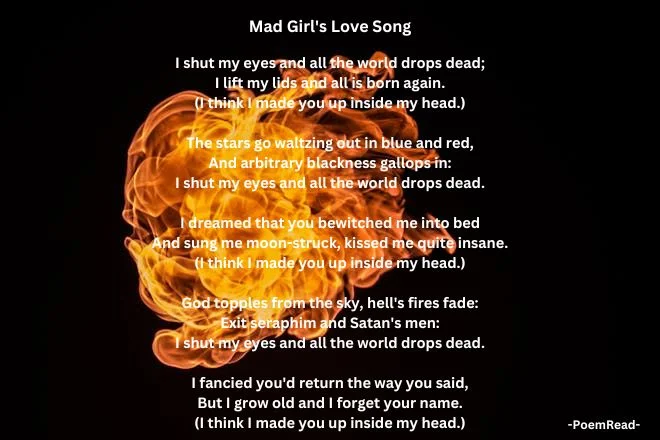
Sylvia Plath’s “Mad Girl’s Love Song” is a captivating exploration of love’s complexities, the fragility of the human mind, and the blurred lines between reality and imagination. This article analyzes this poem, shedding light on Plath’s introspective journey through her evocative language and structured form.
Through vivid imagery, repetition, and symbolism, the poem invites readers to contemplate themes of longing, self-deception, and the timeless nature of emotional turmoil. Let’s dive deep into this literary masterpiece and uncover how love influences our perception and existence.
Mad Girl's Love Song
I shut my eyes and all the world drops dead;
I lift my lids and all is born again.
(I think I made you up inside my head.)
The stars go waltzing out in blue and red,
And arbitrary blackness gallops in:
I shut my eyes and all the world drops dead.
I dreamed that you bewitched me into bed
And sung me moon-struck, kissed me quite insane.
(I think I made you up inside my head.)
God topples from the sky, hell's fires fade:
Exit seraphim and Satan's men:
I shut my eyes and all the world drops dead.
I fancied you'd return the way you said,
But I grow old and I forget your name.
(I think I made you up inside my head.)
I should have loved a thunderbird instead;
At least when spring comes they roar back again.
I shut my eyes and all the world drops dead.
(I think I made you up inside my head.)
Content
- About the Author: Sylvia Plath
- Subject of Mad Girl's Love Song
- Context of Mad Girl's Love Song
- The Theme of Mad Girl's Love Song
- The Tone of Mad Girl's Love Song
- Form and Structure of Mad Girl's Love Song
- Line-by-Line Analysis of Mad Girl's Love Song
- Poetic and Literary Devices Used in Mad Girl's Love Song
- Implications and Meanings of Mad Girl's Love Song
- Interactive Summary of Mad Girl's Love Song
About the Author: Sylvia Plath
Sylvia Plath started out as a writer at a young age, showcasing her talent in high school through award-winning poetry that was honest and marked by raw emotion. Her time at Smith College further honed her skills, with her published works gaining recognition in esteemed literary circles. Plath’s move to England, where she met and married Ted Hughes, added layers to her writing, reflecting themes of love, conflict, and female identity.
Her renowned novel, “The Bell Jar,” under the pseudonym Victoria Lucas, explored mental illness and societal pressures on women. Plath’s tragic death at 30 did not diminish her impact; her writing continues to captivate audiences with its emotional depth and powerful language.
“Mad Girl’s Love Song” epitomizes Plath’s exploration of love’s complexities and the thin line between reality and perception. The speaker’s yearning and doubts about love’s authenticity resonate, reflecting the broader theme of grappling with internal versus external truths.
Subject of Mad Girl’s Love Song
The subject of Sylvia Plath’s “Mad Girl’s Love Song” explores complex emotions surrounding love, memory, and self-perception. Through the persona of a “mad girl,” the poem navigates the blurred boundaries between reality and imagination, questioning the authenticity of emotions and experiences. The speaker’s internal dialogue reveals a tumultuous journey of longing, disillusionment, and introspection. Furthermore, it explores themes of identity, desire, and the fleeting nature of human connections.
The introspective tone of the poem invites readers to consider how memories and emotions shape their perception of reality. It explores love in a deeper way, looking at idealization, self-deception, and the lingering impact of past relationships.
Plath’s personal struggles with mental health and relationships give the poem a raw, confessional tone, reflecting universal themes of love and disillusionment. The “mad girl” persona allows Plath to delve into introspection, encouraging readers to reconsider their views on love, longing, and the complexities of the human mind.
Context of Mad Girl’s Love Song
The context of Sylvia Plath’s “Mad Girl’s Love Song” is crucial to understanding its emotional depth. Plath wrote this poem during her college years at Smith College in the 1950s, a period marked by intense personal struggles. She grappled with mental health challenges and complex relationships, which heavily influenced her writing.
At the time of writing, Plath was experiencing emotional struggles and grappling with conflicting emotions about love and identity. Her experiences of unrequited love and the pressure to conform to societal expectations contributed to the raw, confessional tone of the poem.
“Mad Girl’s Love Song” reflects Plath’s introspective exploration of self-deception, longing, and the transient nature of human emotions. The poem’s context within Plath’s own life underscores its authenticity and emotional resonance, making it a reflection of universal themes of love and disillusionment.
The Theme of Mad Girl’s Love Song
The theme of the poem revolves around the complexities of love, the fragility of the human mind, and the blurred boundaries between reality and fantasy. Plath explores the multifaceted nature of love, exploring its various dimensions, from the intense passion to the devastating pain it can inflict. Through her words, she portrays love as a force that can both uplift and destroy, leaving the speaker in a state of emotional turmoil.
Furthermore, Plath explores the fragility of the human mind, examining the depths of the speaker’s psyche. The poem captures the inner struggles and conflicts that arise from the complexities of love. Furthermore, it reveals the vulnerability of the human mind when faced with intense emotions. Plath’s portrayal of the speaker’s mental state is raw and unfiltered, exposing the innermost thoughts and fears that plague the individual.
In addition to the exploration of love and the human mind, Plath blurs the boundaries between reality and fantasy in the poem. The speaker’s perception of the world becomes distorted as they navigate through the labyrinth of their emotions. Plath’s use of vivid imagery and repetition further enhances this sense of confusion and uncertainty, as the lines between what is real and what is imagined become increasingly blurred.
The Tone of Mad Girl’s Love Song
The tone of the poem is melancholic, reflecting the speaker’s feelings of confusion, longing, and disillusionment. Plath’s use of language and imagery evokes a sense of sadness and despair, capturing the speaker’s emotional state as they grapple with the complexities of love. The poem is filled with a sense of longing, as the speaker yearns for a deeper connection and understanding yet feels trapped within their own thoughts and emotions.
Form and Structure of Mad Girl’s Love Song
Villanelle Form
The form and structure of Sylvia Plath’s “Mad Girl’s Love Song” play a significant role in conveying the poem’s thematic depth and emotional resonance. Plath adopts a villanelle form, a poetic structure characterized by 19 lines divided into five tercets (three-line stanzas) followed by a quatrain (four-line stanza). This structured form not only lends a sense of order and symmetry to the poem but also reinforces its cyclical themes and motifs.
Moreover, the strict structure of the villanelle serves as a metaphor for the constraints and limitations the speaker feels in her life and relationships. The repetition of certain lines and words reflects the speaker’s inability to break free from her obsessive thoughts and escape the cycle of her emotions. The form becomes a representation of the speaker’s mental imprisonment, highlighting the theme of confinement and the struggle for freedom.
Additionally, the use of tercets and a quatrain allows for a gradual progression and development of the speaker’s emotions. Each tercet presents a new facet of her love and madness, building up to the final quatrain, where the intensity reaches its peak. This structural progression mirrors the speaker’s escalating emotions, creating a sense of tension and climax within the poem.
Repetition and Refrains
The use of repetition is a notable feature of the villanelle form, with two key lines repeated throughout the poem:
“I shut my eyes and all the world drops dead;
(I think I made you up inside my head.)”
These lines serve as refrains that anchor the poem, creating a rhythmic pattern and emphasizing the speaker’s introspective journey. The repetition of these lines underscores the theme of self-deception and the blurred boundaries between reality and imagination.
Furthermore, the repetition of the first and third lines of the opening tercet throughout the poem creates a haunting refrain, echoing the obsessive and repetitive nature of the speaker’s love and longing. This repetition not only reinforces the theme of madness but also adds a musical quality to the poem, enhancing its lyrical and emotional impact.
Rhyme Scheme and Musicality
The alternating rhyme scheme (ABA ABA ABA ABA ABA ABAA) adds a musical quality, enhancing the poem’s lyrical flow and emotional impact. The rhyming patterns contribute to cohesion while allowing for tonal variations within stanzas.
Enjambment and Fluidity
Plath’s use of enjambment, where sentences flow without punctuation from one line to the next, creates a fluid and continuous rhythm. This technique adds momentum and intensifies the emotional depth of the speaker’s internal dialogue.
Pauses and Line Breaks
Strategic pauses and line breaks emphasize key moments or ideas, such as the abrupt shifts in imagery or tone. For example, the transition from cosmic imagery to personal reflection creates a stark contrast that captures the reader’s attention.
In essence, the form and structure of “Mad Girl’s Love Song” contribute significantly to its overall meaning and impact. The villanelle’s strict format, rhyme scheme, and repetition enhance the exploration of the speaker’s mental state, the cyclical nature of her thoughts and emotions, and the theme of confinement. Through its carefully crafted structure, the poem captures the essence of the speaker’s turbulent love and madness, leaving a lasting impression on the reader.
Line-by-Line Analysis of Mad Girl’s Love Song

First Stanza
"I shut my eyes and all the world drops dead;
I lift my lids and all is born again.
(I think I made you up inside my head.)"
In these opening lines, the speaker describes the power of their imagination. Closing their eyes, the world ceases to exist, and upon opening them, everything is brought back to life. The parenthetical line suggests that the speaker questions the reality of the person they are thinking of, implying that they might be a creation of their own mind.
“I shut my eyes and all the world drops dead;
This opening line sets the introspective tone of the poem, where the act of closing one’s eyes symbolizes retreating into one’s inner world, away from external influences. The phrase “all the world drops dead” suggests a sense of detachment from reality and a desire for solace.
I lift my lids and all is born again.
The contrast between shutting and lifting one’s eyelids signifies a cyclical process of introspection and renewal. The phrase “all is born again” hints at a fresh perspective or a new beginning upon opening one’s eyes, emphasizing the transformative nature of perception.
(I think I made you up inside my head.)
This refrain introduces the theme of self-deception and questions the authenticity of memories and emotions. The speaker grapples with the blurred lines between reality and imagination, hinting at a longing for something that may only exist in their mind.
Second Stanza
"The stars go waltzing out in blue and red,
And arbitrary blackness gallops in:
I shut my eyes and all the world drops dead."
Here, the speaker continues to explore the transformative power of their imagination. The stars are personified as they waltz, highlighting the beauty and wonder that can be found within the speaker’s mind. The sudden shift to “arbitrary blackness” suggests a sense of darkness and uncertainty. Closing their eyes once again, the speaker finds solace in the temporary escape from reality.
The stars go waltzing out in blue and red,
Here, Plath employs vivid imagery to depict cosmic movements, symbolizing the grandeur of the universe. The colors “blue and red” evoke a sense of ethereal beauty and create a visual contrast against the ensuing darkness.
And arbitrary blackness gallops in:
The sudden shift to “arbitrary blackness” conveys a sense of impending darkness or emotional turmoil. The word “gallops” adds a dynamic quality, suggesting the relentless advance of darkness and chaos.
I shut my eyes and all the world drops dead.
The repetition of the opening line reinforces the cyclical nature of introspection and withdrawal from reality. It echoes the speaker’s desire to escape from external influences and find solace within themselves.
Third Stanza
"I dreamed that you bewitched me into bed
And sung me moon-struck, kissed me quite insane.
(I think I made you up inside my head.)"
In these lines, the speaker delves deeper into their fantasy. They describe a dream where the person they think about seduces them and brings passion into their life. The repetition of the parenthetical line highlights the speaker’s doubt about whether this relationship is real.
I dreamed that you bewitched me into bed
The introduction of a dream sequence adds a surreal element to the poem, blurring the boundaries between fantasy and reality. The word “bewitched” suggests enchantment or manipulation, highlighting the speaker’s vulnerability and susceptibility to illusions.
And sung me moon-struck, kissed me quite insane.
The imagery of being “moon-struck” and “kissed… insane” conveys a sense of overwhelming passion and emotional intensity. The dreamlike quality of the scene amplifies the speaker’s longing and desire for an idealized version of love.
(I think I made you up inside my head.)
The refrain reiterates the theme of self-deception and questioning the authenticity of emotions. The speaker grapples with the idea that their romanticized perception of the beloved may be a creation of their own imagination.
Fourth Stanza
"God topples from the sky, hell's fires fade:
Exit seraphim and Satan's men:
I shut my eyes and all the world drops dead."
Here, the speaker introduces religious imagery to convey a sense of upheaval and transformation. The mention of God and Satan suggests a complete disruption of the speaker’s perception of the world. Closing their eyes once more, the speaker finds comfort in the temporary escape from the chaos.
God topples from the sky, hell’s fires fade:
Plath employs religious imagery to depict a dramatic shift in cosmic order. The imagery of “God topples” and “hell’s fires fade” suggests an existential crisis or disillusionment.
Exit seraphim and Satan’s men:
The departure of angelic and demonic figures further emphasizes the theme of cosmic upheaval and the collapse of established beliefs or ideologies.
I shut my eyes and all the world drops dead.
The repetition reinforces the cyclical theme of introspection and withdrawal, echoing the speaker’s retreat into their inner world amidst external chaos.
Fifth Stanza
"I fancied you'd return the way you said,
But I grow old and I forget your name.
(I think I made you up inside my head.)"
In these lines, the speaker expresses a longing for the return of the person they are thinking of. However, the passage of time has caused the speaker to grow old and forget their name. The repetition of the parenthetical line reinforces the speaker’s doubt about the reality of this relationship.
I fancied you’d return the way you said,
The word “fancied” suggests a fanciful or unrealistic expectation. The speaker holds onto a hope or belief that the beloved will return as promised, showcasing a yearning for reconciliation or closure.
But I grow old and I forget your name.
The passage of time and the fading of memories reflect the transient nature of emotions and relationships. The speaker acknowledges the inevitability of forgetting, hinting at acceptance or resignation.
(I think I made you up inside my head.)
The refrain once again questions the authenticity of memories and emotions, reinforcing the theme of self-deception and longing for a reality that may only exist in the mind.
Sixth Stanza
"I should have loved a thunderbird instead;
At least when spring comes they roar back again.
I shut my eyes and all the world drops dead.
(I think I made you up inside my head.)"
In the final lines of the poem, the speaker reflects on their choices and regrets. They suggest that they should have loved a mythical thunderbird instead, as it would have returned to them with the arrival of spring. The repetition of the closing line emphasizes the speaker’s reliance on their imagination as a means of escape and coping.
I should have loved a thunderbird instead;
The mention of a “thunderbird” introduces a mythical element, symbolizing power and majesty. The speaker reflects on missed opportunities or misplaced affections, suggesting regret or disillusionment.
At least when spring comes they roar back again.
The imagery of spring symbolizes renewal and rebirth, contrasting with the fading memories of the past. The mention of “roar back again” hints at a sense of vitality and resilience.
I shut my eyes and all the world drops dead.
The final repetition of the opening line brings the poem full circle, emphasizing the cyclical nature of introspection and withdrawal. The act of closing one’s eyes symbolizes a retreat into inner contemplation and detachment from external distractions.
(I think I made you up inside my head.)
The concluding refrain echoes the theme of self-deception and questioning the authenticity of memories and emotions. The speaker grapples with the elusive nature of love and the blurred boundaries between reality and imagination, leaving the reader with a sense of introspective contemplation.
Overall, these lines convey a sense of the speaker’s internal struggle with reality and the power of their imagination. The repeated act of closing their eyes and finding solace in the temporary escape from the world suggests a desire to retreat into their own minds.
The parenthetical lines throughout the poem serve as a constant reminder of the speaker’s uncertainty about the authenticity of their thoughts and emotions. Through vivid imagery and introspective reflections, the poem explores the complex relationship between imagination and reality, leaving the reader with a lingering sense of ambiguity and introspection.
Poetic and Literary Devices Used in Mad Girl’s Love Song

Repetition
The repetition of certain lines and phrases, such as “I shut my eyes and all the world drops dead” and “I think I made you up inside my head,” creates a rhythmic and haunting effect, emphasizing the speaker’s thoughts and emotions. The repetition emphasizes the speaker’s obsession with and fixation on the person they are thinking of. It reinforces the theme of unrequited love and the speaker’s inability to let go.
Imagery
Plath uses vivid imagery throughout the poem to evoke a sense of longing, confusion, and introspection. Examples include the stars waltzing, the arbitrary blackness, and the speaker’s imagined encounters with the person they are thinking of.
The imagery not only adds depth and richness to the poem, but it also allows the reader to visualize the speaker’s inner world and the intensity of their emotions. Through the use of imagery, Plath invites the reader to step into the speaker’s mind and experience their unsettling thoughts and feelings.
Personification
The stars are personified as they waltz, adding a touch of enchantment and wonder to the poem. By giving human characteristics to the stars, Plath creates a sense of connection between the natural world and the speaker’s internal state. The personification serves to emphasize the speaker’s longing for a love that is as beautiful and captivating as the stars themselves.
Symbolism
The thunderbird mentioned in the final lines symbolizes the speaker’s desire for a love that will return to them. This contrasts with the uncertainty of the person they are thinking of. The thunderbird, a mythical creature associated with power and strength, represents the speaker’s hope for a love that is enduring and transformative.
It serves as a symbol of the speaker’s yearning for a love that is reciprocated and brings them solace and happiness. The contrast between the thunderbird and the person they are thinking of highlights the speaker’s internal conflict. It also underscores the disparity between their idealized love and the reality of their situation.
Allusion
Religious allusions, such as “God topples from the sky, hell’s fires fade,” evoke themes of existential crisis and disillusionment, adding layers of meaning to the poem.
Metaphor
Metaphors, such as “sung me moon-struck, kissed me quite insane,” create imaginative comparisons that deepen the emotional impact, highlighting the intensity of the speaker’s emotions and the transformative power of love.
Enjambment
Enjambment, seen in lines like “And arbitrary blackness gallops in:” creates a sense of continuity and flow, enhancing the poem’s musicality and propelling the reader through the speaker’s introspective journey.
Implications and Meanings of Mad Girl’s Love Song
“Mad Girl’s Love Song” explores the intricacies of love, the fragility of the human mind, and the blurred lines between reality and imagination. Love is portrayed as both a source of joy and torment, blurring the boundary between reality and fantasy. The repeated lines in the poem highlight the cyclical nature of the speaker’s emotions and thoughts, emphasizing uncertainty and longing.
The poem analyzes the depths of human emotions, depicting the speaker as a “mad girl” driven to madness by love. The use of the word “mad” signifies intense emotions and challenges societal norms about expressing such feelings. The blurred lines between reality and imagination add to the confusion, questioning the nature of love and perception.
Time is a significant theme, juxtaposing the speaker’s longing with the passage of time. The repetition of “I shut my eyes and all the world drops dead” suggests a timeless longing, highlighting love’s power to distort reality.
In sum, “Mad Girl’s Love Song” is introspective, delving into love’s complexities, the human psyche, and the boundary between reality and fantasy. Through repetition and imagery, it invites reflection on love’s profound impact on perception and life.
Interactive Summary of Mad Girl’s Love Song
Sylvia Plath’s “Mad Girl’s Love Song” navigates the intricacies of love, the human psyche, and the intersection of reality and fantasy. Through repetitive lines and vivid imagery, the poem captures the speaker’s cyclical emotions of longing and uncertainty.
Plath’s use of literary devices like repetition, personification, and symbolism adds depth to the exploration of love’s transformative power and the fragility of perception. The poem’s structured form, with its rhythmic flow and haunting refrains, invites readers to reflect on the complexities of emotions and the blurred boundaries between what is real and imagined.
If you’re intrigued by “Mad Girl’s Love Song,” I highly recommend reading Sylvia Plath’s “Mirror” for a deeper exploration of introspection and self-perception.
RELATED POSTS
View all



